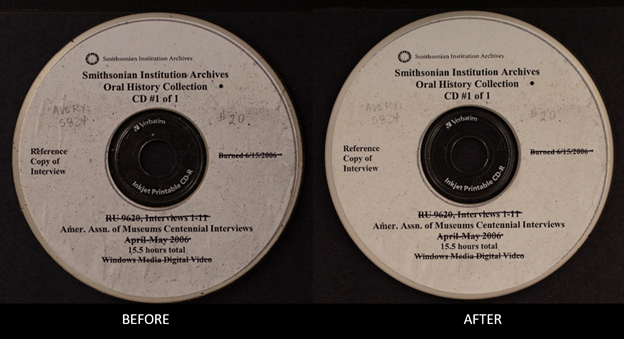In the first part of this series I introduce my research on treating CDs and DVDs that underwent a test-fire. I outlined my variables and discussed my first set of cleaning tests for these discs which were covered in soot and water spots.
The second round of cleaning tests explored the use of solvents to remove soot from the discs. The solvents would be applied with one of the four cleaning tools that we decided to use after our initial tests: Kimwipes, PEC-PAD wipes, cotton swabs, and soot sponges. (The Japanese brush would be the first tool I used to remove any loose debris from the surface, as is common practice.) We decided to stick with reverse osmosis (filtered) water and 70% isopropyl alcohol as suggested by the literature. These are also inexpensive and commercially available and therefore accessible to many people and institutions. If we decided that we did not like the results from these two solvents, then we could add more test solvents later.
For this second round of tests, I grabbed some of the soot-covered discs that we had prepared and divided the front and back surfaces into four sections:
- Control: no cleaning would be done in this area
- Dry application: where the cleaning tool would be applied with no solvent
- Water: where the tool would be applied with a few droplets of distilled water
- Isopropanol: where the tool would be applied with a few droplets of isopropyl alcohol (also known as isopropanol)
Each of these four areas was divided in half, where one half was covered with a pressure-adhesive backed white paper label and the other was not. (Pressure-sensitive adhesive labels are not recommended for use on discs of permanent value, but they exist in archives as received accessions nonetheless). These divisions would help us compare different cleaning methods.
After making these divisions, I tested each tool with the solvents. Below is an image of the test with the soot sponge.

After noting my observations on the best cleaning methods, I was finally ready to move onto treating the discs from the burn. There were three treatment scenarios for the varying conditions of the discs:
- Sample set 1: Discs inside of the storage box which did not sustain damage from the fire event
- Sample set 2: Discs that were in the box with no lid, and had no label attached to the surface
- Sample set 3: Discs that were in the box with the lid, and did have a label attached to the surface
Sample set 1 discs only required a gentle wipe of the surface with a dry Kimwipe to remove dust and maybe a fingerprint or two.
Sample set 2 and set 3 discs sustained water and soot damage from the fire. In both cases, I first used the Japanese brush to gently sweep the looser soot particles into a vacuum. Then, for the sample set 2 discs, I applied a damp Kimwipe with the reverse osmosis water, followed by a dry Kimwipe to remove any excess water. I then applied a damp Kimwipe with isopropanol, followed by a dry Kimwipe. After that, I let the disc air dry. During my cleaning tests, I observed that just passing a Kimwipe with water did not remove the soot entirely from the surface. Additionally, only doing a pass with a Kimwipe with isopropanol smeared the soot. These observations helped me formulate my final cleaning workflow: combining both solvent applications, applying a Kimwipe first with water then with isopropanol, gave me the benefits of both solvents while addressing their drawbacks.
For sample set 3 discs, I wiped the surface with a dry soot sponge only on the label side of the disc, which was effective in removing the soot from the label. We decided not to remove the labels from the discs, as this would save us time and because we determined the soot sponge removed enough of the soot that it would be safe to insert into the computer’s disc drive.
After cleaning the discs, I took photographs of them. I was now able to enter into the final stage of the research.
Tune in next month for part three of this series.
Further Reading:
- "Burn This Disc: Treating Fire-Affected Optical Discs, Part I" by Miguel Resendiz, The Bigger Picture, Smithsonian Institution Archives
- "Return of…the Beast" by Nora Lockshin, The Bigger Picture, Smithsonian Institution Archives
- Longevity of Recordable CDs, DVDs and Blu-rays — Canadian Conservation Institute (CCI) Notes 19/1 by Joe Irachi, Canadian Conservation Institute
- "Glaring Discs: Photographic Condition Documentation of Reflective Surfaces" by Miguel Resendiz, The Bigger Picture, Smithsonian Institution Archives
Produced by the Smithsonian Institution Archives. For copyright questions, please see the Terms of Use.



Leave a Comment